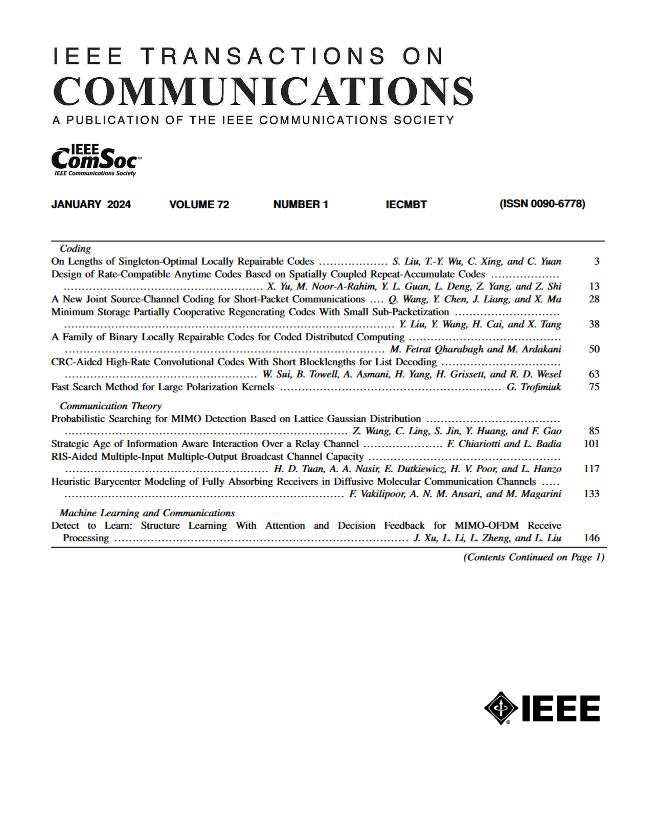面向感知 AoI 的 V2I 网络的联合通信、传感和 MEC
IF 8.3
2区 计算机科学
Q1 ENGINEERING, ELECTRICAL & ELECTRONIC
引用次数: 0
摘要
随着各种各样的应用出现在车辆到基础设施(V2I)网络中,数据的爆炸式增长对通信和计算提出了更高的要求。传感技术通过收集实时环境信息提供准确的数据。同时,移动边缘计算(MEC)可以显著降低通信延迟,提高计算效率。因此,将这两种新技术集成到V2I应用中以提高整体性能已成为研究热点。在本文中,我们重点研究了在V2I网络的联合通信、传感和MEC框架下,确定缓存、卸载和匹配策略以最小化系统成本的优化问题。首先,我们分析了感知对信号开销和信息年龄(AoI)的积极影响,并推导了延迟和AoI之间的线性关系。其次,我们建立了系统成本的优化函数,将其定义为AoI和能耗的加权和,并证明了它是np困难的。为了解决这个问题,我们利用改进的量子粒子群优化(QPSO)算法来获得缓存和卸载策略的次优解。与通过分支定界(B&B)方法获得的最优解相比,这大大降低了计算复杂度。根据车辆的AoI,设计了路边单元(RSU)与车辆的匹配算法。在此基础上,我们提出了一种基于qpso的联合通信、传感和MEC框架(QJCSM)算法。仿真结果表明,QJCSM算法在AoI和能耗方面优于其他基准算法,以较低的复杂度实现了接近最优的性能。本文章由计算机程序翻译,如有差异,请以英文原文为准。
Joint Communications, Sensing, and MEC for AoI-Aware V2I Networks
As a large variety of applications emerge in vehicle-to-infrastructure (V2I) networks, the explosion of data places greater demands on communications and computing. Sensing technology offers accurate data by collecting real-time environmental information. Meanwhile, mobile edge computing (MEC) can significantly reduce communication latency and enhance computational efficiency. Therefore, integrating the two novel technologies into V2I applications to improve overall performance has become a research hotspot. In this paper, we focus on the optimization problem for determining caching, offloading, and matching strategies to minimize system cost under the joint communications, sensing, and MEC framework of V2I networks. First, we analyze the positive impact of sensing on signaling overhead and age of information (AoI), and derive a linear relationship between delay and AoI. Next, we formulate the optimization function of system cost, which is defined as the weighted sum of AoI and energy consumption and is proved to be NP-hard. To address this problem, we leverage an improved quantum particle swarm optimization (QPSO) algorithm to acquire a suboptimal solution of caching and offloading strategies. This significantly reduces computational complexity compared to the optimal solution obtained via the branch-and-bound (B&B) method. According to the vehicles’ AoI, we design a matching algorithm for the roadside unit (RSU) with vehicles. Building on these, we propose a QPSO-based algorithm under the joint communications, sensing, and MEC framework (QJCSM). Simulation results demonstrate that the QJCSM algorithm outperforms other baseline algorithms in terms of AoI and energy consumption and achieves near-optimal performance with low complexity.
求助全文
通过发布文献求助,成功后即可免费获取论文全文。
去求助
来源期刊

IEEE Transactions on Communications
工程技术-电信学
CiteScore
16.10
自引率
8.40%
发文量
528
审稿时长
4.1 months
期刊介绍:
The IEEE Transactions on Communications is dedicated to publishing high-quality manuscripts that showcase advancements in the state-of-the-art of telecommunications. Our scope encompasses all aspects of telecommunications, including telephone, telegraphy, facsimile, and television, facilitated by electromagnetic propagation methods such as radio, wire, aerial, underground, coaxial, and submarine cables, as well as waveguides, communication satellites, and lasers. We cover telecommunications in various settings, including marine, aeronautical, space, and fixed station services, addressing topics such as repeaters, radio relaying, signal storage, regeneration, error detection and correction, multiplexing, carrier techniques, communication switching systems, data communications, and communication theory. Join us in advancing the field of telecommunications through groundbreaking research and innovation.
 求助内容:
求助内容: 应助结果提醒方式:
应助结果提醒方式:


